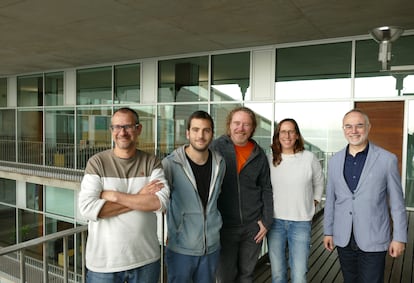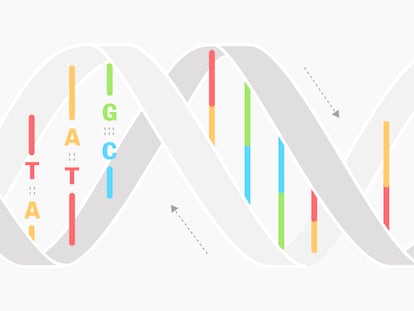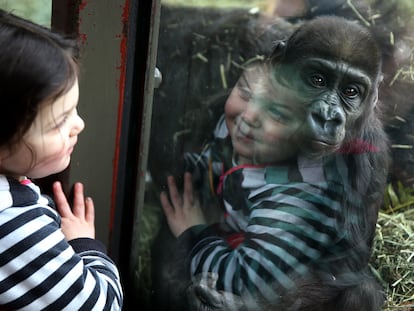Reading DNA from 233 primate species sheds light on what defines the human species and how human diseases emerge
The wealth of genetic information will make it easier to identify pathological mutations, such as the ones that cause cancer

The last common ancestor of people and chimpanzees roamed the Earth about seven million years ago. That may sound like a long time, but it’s about the same span that separates African elephants and Asian elephants, two species so similar that people often simply call them elephants. Biologist Tomàs Marquès Bonet is working to answer one of humanity’s great questions: what makes us human? More specifically, what happened in that seven-million-year period to allow people to be able to walk on the moon while all other primates are still in tree branches? This Thursday, our understanding took a giant step forward. An international consortium led by Marquès Bonet has read the DNA of 233 primate species, half of all known species. This monumental genetic information is being used to determine what a human being is, as well as shed light on the origins of many diseases, such as cancer.
A person’s genome, his or her DNA, is a text of more than 3 billion chemical letters that provide instructions telling each cell what to do. “If we sequence a sick person’s DNA, we will find thousands of mutations that could be linked to that disease,” explains Marquès Bonet, of the Institute of Evolutionary Biology in Barcelona. The researcher explains that five years ago, the US company Illumina, a world leader in DNA sequencing technology, proposed coordinating a macro-project to read the genomes of hundreds of primate species. The project’s goal was to create a genetic catalog to identify the specific variants of human diseases. The results of that study were published on Thursday in a special issue of the journal Science.
“If you see a mutation in a patient and you also find it in several primate species, discard it, because it is probably not the cause of the disease. On the other hand, if you find a mutation that only appears in a tumor tissue and has never been seen in any other primate, that mutation must do something disruptive in the cell and is a perfect candidate [for further examination],” Marquès Bonet explains.
The consortium has analyzed the DNA of over 800 individuals from 233 species, including those closest to humans—chimpanzees, gorillas and orangutans—as well as some critically endangered species, such as the Sahafary jumping lemur (only 40 specimens remain in the wild in Madagascar). The researchers have used this data to train an algorithm to identify disease-associated mutations. This new artificial intelligence tool has revealed 73% more links between genetic variants and pathologies, according to a study carried out with the UK Biobank, a registry of biomedical data from almost half a million volunteers..

“We have put the algorithm to work on complex diseases, such as diabetes and cancer, where the cause is obviously not a mutation in a gene, but a combination of many things,” says Marquès Bonet. “There are common mutations that contribute, as we’ve seen [before], but [now], for the first time, we can say that there are rare mutations that have a major impact on these complex diseases. And we have achieved this [by using] an algorithm trained on primates,” the biologist says. His research institute is affiliated with the Spanish National Research Council (CSIC) and Pompeu Fabra University.
Marquès Bonet explains that, when they started the project five years ago, the genomes of just a couple of dozen primate species had been sequenced. “Going from 20 to 233 is a huge increase, which allows us to better filter out what is exclusively human and what is not. Basically, we have halved the candidates for mutations that define our species,” says the researcher. His team has detected 89 variants in 80 genes that are crucial for explaining what a human being is. As an example, Marquès Bonet cites the NOVA1 gene, which acts like an orchestra conductor in early brain development.
16% of the human genome is more similar to the gorilla genome than to the chimpanzee genomeIker Rivas González, specialist in bioinformatics
The paths of chimpanzees and humans diverged over seven million years ago. Gorillas left the common path earlier, about eight million years ago, according to Iker Rivas González, a bioinformatics specialist at the University of Aarhus (Denmark). “However, about 16% of the human genome is more similar to the gorilla genome than to the chimpanzee genome,” emphasizes Rivas González, who led one of the eight studies published in the special issue of Science. Rivas González’s team studies this phenomenon, which causes parts of the same genome to have different evolutionary histories. His group has found that there are genes linked to the fur or the immune system that are evolving faster than the rest in primate genes.
Primatologists around the world are looking to monkeys and apes for clues about human social evolution. Julia Fischer of the German Primate Center studies Guinea apes, 15-kilogram African monkeys with unique behavior: the females choose the male they want and no longer mate with any others. Meanwhile, the males wait to be chosen by one or more females and copulate with all of them. The question is to what extent these behaviors are rooted in DNA.
“It’s an absolutely fantastic question,” says Marquès Bonet. Over a decade ago, his group participated in the first sequencing of chimpanzee and bonobo genomes. The former form highly violent patriarchal groups, while bonobos form peaceful matriarchal societies that use sex to resolve conflicts. “So, we looked for areas of the genome associated with those behaviors and didn’t find them, but that doesn’t mean they’re not there,” he says. The wealth of data on primates now opens the door for new discoveries.
Sign up for our weekly newsletter to get more English-language news coverage from EL PAÍS USA Edition
Tu suscripción se está usando en otro dispositivo
¿Quieres añadir otro usuario a tu suscripción?
Si continúas leyendo en este dispositivo, no se podrá leer en el otro.
FlechaTu suscripción se está usando en otro dispositivo y solo puedes acceder a EL PAÍS desde un dispositivo a la vez.
Si quieres compartir tu cuenta, cambia tu suscripción a la modalidad Premium, así podrás añadir otro usuario. Cada uno accederá con su propia cuenta de email, lo que os permitirá personalizar vuestra experiencia en EL PAÍS.
¿Tienes una suscripción de empresa? Accede aquí para contratar más cuentas.
En el caso de no saber quién está usando tu cuenta, te recomendamos cambiar tu contraseña aquí.
Si decides continuar compartiendo tu cuenta, este mensaje se mostrará en tu dispositivo y en el de la otra persona que está usando tu cuenta de forma indefinida, afectando a tu experiencia de lectura. Puedes consultar aquí los términos y condiciones de la suscripción digital.
More information
Archived In
Últimas noticias
Most viewed
- Reinhard Genzel, Nobel laureate in physics: ‘One-minute videos will never give you the truth’
- Oona Chaplin: ‘I told James Cameron that I was living in a treehouse and starting a permaculture project with a friend’
- Pablo Escobar’s hippos: A serious environmental problem, 40 years on
- Chevy Chase, the beloved comedian who was a monster off camera: ‘Not everyone hated him, just the people who’ve worked with him’
- Why we lost the habit of sleeping in two segments and how that changed our sense of time











































